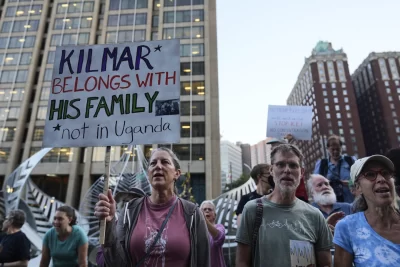
With tired faces, residents of a homeless shelter in Argentina’s capital pass through the main entrance and line up to receive a hot drink and a slice of cake for an afternoon snack.
Places like the Bepo Ghezzi Social Inclusion Center in the Parque Patricios neighborhood of Buenos Aires have seen demand soar as more people are struggling to make ends meet amid an annual inflation rate above 100%.
The portion of Argentines living in poverty reached 40.1% in the first six months of the year, according to figures released Wednesday by the government’s INDEC statistics agency. That is up from 39.2% in the second half of 2022.
“I was renting, and it increased. I couldn’t afford it,” said Lionel Pais, 37, who arrived at the shelter three weeks ago, just after the government devalued the Argentine peso almost 20%, setting off another surge in prices. “These sudden increases that occurred, the economic situation in the country, don’t allow me to cover basic expenses.”
For much of the 20th century, Argentina showed a social mobility dynamic that gave rise to a large middle class and made the country stand out in the region. But the good times derailed, and poverty has remained firmly above 25% the last two decades as the South American country stays mired in economic malaise. Prices soared 124.4% during the 12-month period through Aug. 31.
“It’s a peaceful place,” he said of the shelter.
But the clock for Boned, and all of the shelter’s other residents, is ticking. These shelters guarantee housing for only three months. During that time, residents are given guidance on finding work and applying for a subsidy to help them with their rent.
“Most of them tell you their salary doesn’t cover their needs,” said Mercedes Vucassovich, a social worker who runs the Bepo Ghezzi center.
The median monthly income in Argentina was 87,310 pesos ($237) during the second quarter of the year, according to INDEC. A typical family needs more than 280,000 pesos ($765) to stay out of poverty.
In Morón, a suburb west of the capital, María de los Ángeles García and Adrián Viñas Coronel, along with their five children aged 3 months to 13 years, are renting a makeshift dwelling in a low-income neighborhood after spending six months on the streets. With an address, they can enroll their children in a public school.
Their only fixed income is about 90,000 pesos ($245) a month in social assistance, of which they have to allocate 25% to rent.
“We have to work all day on the street because we don’t have enough for food nor diapers for the kids,” said García, 31.
Over the past few weeks, Economy Minister Sergio Massa, who is running for president, has unveiled a series of measures to try to help Argentines who have seen their purchasing power decimated. Most recently, he said those who are not formally employed and not already getting any form of welfare will receive 94,000 pesos ($256) divided into two monthly payments, in October and November.
The measures come as Massa is trying to gain ground on right-wing populist Javier Milei, who leads in opinion polls ahead of the Oct. 22 presidential election. He says he will turn to dollarization to end inflation.
García and her family receive some help through the Corazon Azul NGO, which provides snacks, medical assistance and donations of goods to vulnerable people in the area.
Among them is Alejandro Heredia, 53, who sleeps on trains and collects cans to sell for recycling.
“When you think you’re in a bad situation, it always gets worse than it already was,” he said. “We’ve been like this for 40 years, and there have been several governments.”




